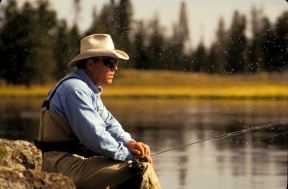
Without doubt, the hottest topic last season was what is going on with the ranch. This dialogue has been thrashed around on social media, national fly fishing publications, and other arenas. Elevated water temperature, flushed sediment, high flows, floating aquatic vegetation, water quality and poor insect hatches cover most of the complaints. Much of this frustration has been directed at the Henry’ Fork Foundation.
The Railroad Ranch, known today as the Harriman State Park, is one of the most famous pieces of trout water in the world. My history with this magnificent place goes all the way back to my birth. My mother, grew up in Ashton and worked in the ranch for the Harrimans in the summers during her high school years. My father worked for the Union Pacific Railroad. He had a very close relationship with Ben Meece, who was the ranch manager from 1966 – 1977. Ben let us fish on Golden Lake and Thurmon Creek a few times before I was old enough to fish the river. I fished the ranch with wet flies during my high school years. I never got into the dry fly stuff until after I got out of college.
When I share my legacy and history with the ranch I doubt anybody gives much of a damn. I am sharing this solely to prove that from a business owner and personal angler’s perspective, I am more than qualified to share my thoughts and comparisons over the years. Most people were very disappointed in the fishing the past couple of seasons. Overall, the ranch sucked in 2022.
Nobody can rightfully argue against the seriousness of the decline of the ranch. From my perspective there are a number of issues that are having a negative effect on the ranch. Turbidity, water temperature, stream flows, drifting aquatic vegetation, water quality, and poor insect hatches.
Turbidity
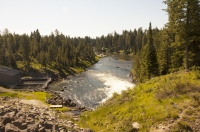
Of all of the issues facing the Box Canyon and the Ranch, turbidity ranks at the top. Island Park Dam began operation in 1939. All reservoirs have a life span. Eventually they fill up with sediment and other materials. I think the reservoir is on the downside of its life span. It will be a colossal endeavor to minimize or alleviate the turbidity problem.
In 2022 I think the Henry’s Fork Foundation did about all they could to minimize turbidity. The weather and associated irrigation demand was a major factor. I think the greatest accomplishment was more water in the reservoir than originally predicted and better winter flows than expected.
The Henry’s Fork Foundation has listed the following strategies to help resolve the turbidity issue:
* Keep Island Park Reservoir as full as possible all summer
* Reduce summertime outflows
* Springtime high flows (“freshet”) to clear settled sediment
* Minimize flow through gates side of dam
* Reduce power plant DO requirement to statewide standard
I don’t see anything new here. All of these strategies are already being utilized. They have been trying to follow these strategies for years. I’m sure all of these strategies have been beneficial to the ranch but there are still serious issues with turbidity. This is a Band-Aid approach. To really improve the sediment issue it has to be attacked at its source.
The Henry’s Fork Foundation offered a couple of promising long-term solutions. Two of these long-term strategies are to modify the existing power plant or to physically remove sediment from the reservoir itself. These two strategies are quickly blown off because of the expense and government agency oversight. As a member of the Henry’s Fork Foundation since its creation, I can’t remember when we ever ran away from such a major issue. If the sediment issue is not dealt with at its source we’ll continue to see more and more sediment in the years to come.
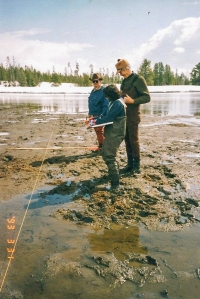
There have always been issues with turbidity. Years ago it wasn’t as common as it is now. Sometimes early runoff caused turbidity below the dam. Mid-summer flows due to high irrigation demand sometimes caused the water to be off-colored. The reservoir was completely drained on several occasions. 1992 was the most catastrophic when an estimated 90,000 tons of sediment was flushed into the river. This happened because it was a very dry year and irrigators used a lot of storage water but not all of it. The Idaho Department of Fish and Game followed that up by lobbying for the reservoir to be completely drained so they could poison the remaining pool of water with Rotenone. They got their wish. The sediment in the Millionaire’s Pool was two feet deep.
Some of us thought the fishing on the ranch was history and I contemplated looking for another job. Yet we learned how resilient the river can be if the sediment is controlled at its source. I don’t know how much sediment is sitting at the bottom of the reservoir and I doubt anybody else knows including the Henry’s Fork Foundation. Unlike years back when murky water was somewhat predictable, whenever the sediment in the reservoir is disturbed it flushes into the river.
Water Temperature
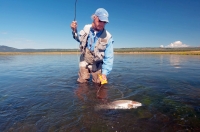
I don’t have a lot of personal data with regard to water temperature today compared to the old days. The ranch has always had issues with water temperatures. I have used a stream thermometer for many years. I can remember instances I had a water temperature of 72F or more at the Osborne Bridge.
The reservoir was retrofitted with a hydroelectric facility in 1994. I ended up testifying before a congressional committee in Washington on behalf of the Henry’s Fork Foundation. We were able to influence the developer to implement safeguards to minimize impact on the river including, but not limited to, water temperature, turbidity, and dissolved oxygen. The inflow is through a siphon that draws water from a higher elevation than the gates. There are benefits and negatives with regard to the power plant. What we didn’t consider, or know, at the time was that it was hard to achieve all of these benefits at the same time.
The Island Park Reservoir is relatively shallow. Much of the storage water is to the west of the old river channel that runs from McCrea Bridge to the Island Park Dam. During heat spells, especially when the reservoir is drawn down the sun heats the surface area and water temperature is elevated. I’m not a scientist but I think more study is warranted to determine what, if anything, can be done to improve the situation.
Streamflow
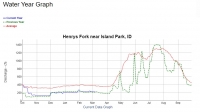
There has been a lot of criticism about high flows. If one looks back over the years at the historical data of outflows from the Island Park Dam you’ll see that the average high flow is 1300 cfs compared to a high of 1400 cfs in 2022. It was at this flow for only about two weeks.
High water years provide more flow during the winter which benefits young of the year trout. On high water years irrigation demand is reduced until later in the spring or summer, usually early to mid-July. On low water years, the effect on streamflow is opposite. You’ll note from the graph that in 2022 the winter flow was a little over 200 cfs compared to an average of almost 400 cfs. On average flows are higher from mid-May through mid-June because of runoff. Then the flow drops off until after the middle of June. In 2022 the graph looks a lot like my last Electrocardiogram. Erratic flows in 2022 were mostly a result of erratic weather. The graph tells the story.
2022 started out as one of the driest, if not the driest year on record. It was evident that Island Park Reservoir, Palisades Reservoir and other reservoirs would not fill. This wasn’t my first rodeo and I fully expected the reservoir to be completely drained as happened in 1992. Some people have a different view of the old versus today but the fact is, there were years when the reservoir was completely drained and the outflow shut completely off for the entire winter leaving the inflow of the Buffalo River as the only source of inflow. This is fact and you can look up the data to prove it. Water users did everything they could to save water but irrigation demand would have started in early June. Then the rains came. Rain, snow and cold weather provided much needed inflow to the reservoir and decreased irrigation demand. This lowered the flow back to under 300 cfs as the reservoir continued to fill. Everything started to look more promising until the weather changed to warm (very warm) and dry. This created havoc with the flows about the time the ranch opened. After this moderated the flow dropped back until mid-July when irrigation demand ramped up.
The Henry’s Fork Foundation has had much more influence on streamflow and reservoir capacity than back in the old days. This was not the year to be critical of the Henry’s Fork Foundation over streamflow. The reservoir ended the season at 25,000 acre feet compared to what I predicted to be near nothing. The erratic flows also had a major effect on the turbidity.
Aquatic Vegatation
Last season drifting aquatic vegetation and algae created a serious negative experience on the ranch. This is a problem that has been intensifying over the years. Suspended vegetation and algae was almost impossible to deal with late in the season, after the flows became more stable and the hatches improved. Now anglers had the problem of their fly getting clogged with green, nasty gunk, and if they were fortunate enough to hook a trout, it usually came off or broke off in the weeds. September was always my favorite time to fish the ranch. I liked it because the hatches were good and the water was low and clear. I’m not an aquatic botanist but back then, I only remember rooted aquatic vegetation. There was none of this drifting stuff until recent years.
This problem doesn’t exist only in the ranch. It can be a real problem below the Ashton Dam. Maybe I’m not looking in the right place but I haven’t seen many ideas for solutions for the problem. From the Henry’s Fork Foundation perspective, they are very good at identifying problems. However, anybody that fished this water last season didn’t need the Henry’s Fork Foundation to explain what the problems were. Anglers experienced it firsthand.
Hatches
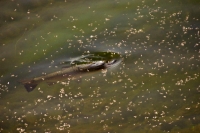
When I was doing research on aquatic insects for my book, Spring Creeks, I spent time with Dr. George Edmunds (University of Utah) and Dr. Steve Jensen (Southwest Missouri State University) to better understand aquatic insects, especially mayflies and caddisflies. One of my best friends was Gary Lafontaine. When he was writing his great book, Caddisflies, he used the east side of our shop as one of his study areas to collect insects.
From these experts I learned important requirements for aquatic insects to survive and thrive. Their populations and emergences are dependent on water quality, water temperature, and habitat. Determining aquatic insects from an angler’s point of view by looking at the number of emerging insects on the water is not reliable. When conditions are right the surface can be covered with adult insects but if conditions are poor you won’t likely see many insects but that doesn’t mean they aren’t there. The best method to determine aquatic insect populations is to study the nymphal or larval stage of the insects.
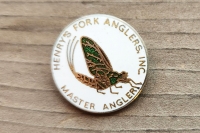
While the opinions of anglers with regard to hatches are not scientific, their opinions should not be cast aside. Most anglers who fished the ranch on a regular basis believe the hatches dropped off, especially in 2022. While not scientific, we have some interesting statistics for the years 1982 through 1992. During that period, as an incentive to release larger trout, we implemented our Master Angler award. When an angler caught and released a trout over 18” and measured by the guide, we presented them a nice pin, certificate and recognized them on our Master Angler wall in the shop and in our newsletter. In 1988 we raised the minimum length to 20 inches. These records list the date, client’s name, species of trout, length, location it was caught, and what it was caught on. These statistics provide an interesting perspective onwhat fishing was actually like back in the early years. Back then we ran a much higher percentage of our trips from Last Chance to Pinehaven. I’m missing years 1984, 1988 and 1990.

Our records clearly show that the hatches were definitely much better in the 1980s and 1990s. You’ll see from the summary of the years1982 through 1992 most of the trout were caught on aquatic insect imitations and beetles and ants. Trout caught with these patterns were usually feeding on the surface. An ant or a beetle is a good go-to pattern when the trout are selectively feeding on something else. The same is true with small attractor patterns. Other patterns include leeches and nymphs. However most trout caught with nymphs then, as now, were cast to sighted trout. Only 6.5% were caught on hoppers. Today that number is unheard of. I believe that more trout have been caught on the ranch blind fishing a hopper pattern than all other dry fly imitations combined.
While water temperature and water quality have most likely had a negative effect on aquatic insects, the greatest impact has been loss of habitat due to silt and sediment.
The Henry's Fork Foundation
Please note that my opinion about the Henry’s Fork Foundation is my own. It does not reflect the views of our business or our customers.
My relationship with the HFF began when we founded the organization in 1984 to successfully battle the construction of hydroelectric projects on the Henry’s Fork between Riverside Campground and Mesa Falls. About the same time we had another big fight with the Idaho Parks and Recreation over destruction of the streambanks due to cattle grazing. We were an all-volunteer organization. We received our 501C(3) tax exempt status in February 1986. I served as Executive Vice President with Mick Mickelson President, Will Godfrey Vice President, and a 5 member board of directors with Bill Manlove as chair. I served again as a member of board from 2015 through 2018.
With my recent tenure on the board I realized that HFF isn’t the same organization. According to the latest newsletter, one reason the HFF doesn’t want to pursue long term solutions to our sediment problem is cost and regulatory oversight. That’s never stopped us in the past. We might fail at this endeavor but shouldn’t we at least try? Cost hasn’t been and issue with regard to other projects.
The HFF bought the old hospital to expand into a large campus. Could they have upgraded and expended their old building, which was donated by member, instead? How much of this expense could have been utilized to help with the cost of modifying the power plant or removing sediment from the reservoir? One of the reasons given for the need for a new building was employee housing. What if you didn’t need it? 10 years ago in 2012 the administration and staff was 8 including the executive director. According to the HFF website it has ballooned to 20.
My concern with of the current size of the staff raises the question as to the total expense for wages, payroll taxes and benefits. I’d really like to know what this number is relative to the overall expenses. More importantly, all of these employees have their individual responsibilities which makes it very difficult for the entire team to focus on this crisis.
When we first started the Henry’s Fork Foundation we were mostly focused on the ranch. We realized then, as it is now, the ranch was the focal point of the river. Our mission statement was The Henry’s Fork Foundation is the only organization whose sole purpose is to conserve, protect and restore the unique fisheries, wildlife and aesthetic qualities of the Henry’s Fork. Now with the growth of the HFF to include other waters in our watershed the mission statement now includes the Henry’s Fork and its watershed. This was added when the HFF took on the South Fork Initiative. I don’t want to go off on that, however this issue has also been a very hot and controversial topic since it was implemented.
It is very difficult to be critical of the very organization I helped organize and found. I think it has veered way off course. The question is “can this change?” The Henry’s Fork is again in crisis.